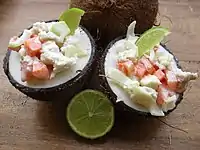'Ota 'ika
ʻOta ʻika is a Oceanian dish consisting of raw fish marinated in citrus juice and coconut milk. The Tongan, Tahitian, and Samoan variants are essentially identical in that the raw fish is briefly marinated in lemon or lime juice until the surface of the flesh becomes opaque. The fish is then mixed with coconut milk and diced vegetables (most commonly cucumber, tomato, onion, green onion, and spicy peppers). This is the national dish of Tonga.
.jpg.webp) ʻOta ʻika | |
| Alternative names | Coconut fish, Ika mata, Iʻa ota, Kokoda, Oka iʻa, Oraora, Ota, Poisson cru |
|---|---|
| Type | Salad |
| Course | Appetiser |
| Place of origin | Oceania |
| Region or state | American Samoa, Cook Islands, Fiji, French Polynesia, Kiribati, Nauru, New Zealand, Niue, Norfolk Island, Papua New Guinea, Pitcairn Islands, Samoa, Tokelau, Tonga, Tuvalu, Wallis and Futuna |
| Main ingredients | Fish, lemon, lime, coconut milk |
| Similar dishes | Kinilaw, kelaguen, hinava, poke, ceviche |
Names
- Cook Islands: ika mata
- Fiji: kokoda
- French Polynesia: poisson cru, iʻa ota
- Nauru: coconut fish
- Niue: ʻota ʻika
- Samoa: oka iʻa
- Tokelau: ʻota ʻika
- Tonga: ʻota ʻika
- Tuvalu: ika mata
- Wallis and Futuna: ika ota
The dish is otherwise known as coconut fish in Nauru, kokoda in Fiji and Papua New Guinea, oka in Samoa, ika mata in the Cook Islands and New Zealand, oraora in Kiribati, and simply poisson cru on the French islands.[1] The word "ota" means "raw" within the Polynesian language group, although the more common term for the dish in French Polynesia is its French equivalent, "poisson cru" (literally, "raw fish").[2][3] Any type of seafood can be used to make "ota," the word "ika" means fish ("i'a" in Samoan language), but the dish is often prepared with mussels ("ota pipi/maso"), prawns ("ota ulavai"), crab ("ota pa'a/paka"), lobster ("ota ula"), octopus/squid ("ota fe'e/feke"), sea urchin ("ota vana/tuitui"), and eel ("ota pusi").
Gallery
- Variants
 Cook Islands Ika mata.
Cook Islands Ika mata. Tuna Poisson cru, served on a banana leaf.
Tuna Poisson cru, served on a banana leaf. Kokoda in Fiji
Kokoda in Fiji
Similar dishes
A very similar dish are the kinilaw and ata-ata of the Philippines, and its descendant dish, the kelaguen of the Marianas Islands. The poke and lomi salmon of Hawaii are also similar. It is also similar to the Latin American ceviche, though the latter is relatively recent and may be a derivative dish, as citruses are not native to the Americas.
See also
Sources
- Brillat, Michael (1999). South Pacific islands (1st ed.). Munich, Germany: Nelles Verlag. ISBN 3-88618-104-9. OCLC 43578477.
- The World's Best Street Food: Where to Find It and How to Make It. Lonely Planet Publications. 2012. p. 131. ISBN 978-1-74321-664-4. Retrieved July 30, 2016.
- Haden, Roger (2009). Food Culture in the Pacific Islands. ABC-CLIO. p. 133. ISBN 978-0-313-34492-3.
Further reading
- "ʻOta ʻika (raw fish in coconut milk)", The Polynesian Kitchen